Brickwork Restoration: How to Work with Lime
By Mario Cantin
The following article is based on opinion and does not necessarily reflect the views of the Mason Contractors Association of America or its members. The MCAA suggests you look to additional resources for more information regarding restoration and working with lime.
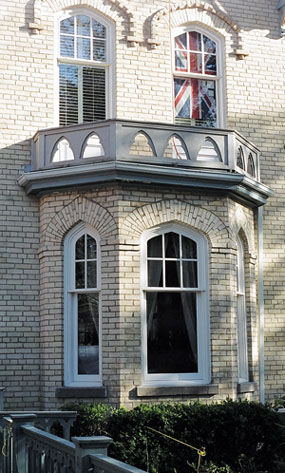 The repaired area blends in perfectly with the rest of the façade, which was mostly untouched. |
Using History as Your Guide
Portland cement is a synthetic substance, made by heating a limestone and clay mixture in a kiln and pulverizing the resulting material. It was first patented in England in 1824 by John Aspdin, a bricklayer, and further advanced by Isaac C. Johnson in 1845. By 1860, subsequent refinements yielded a product very similar to the Portland cement we use today. In 1872, the United States began manufacturing Portland cement.
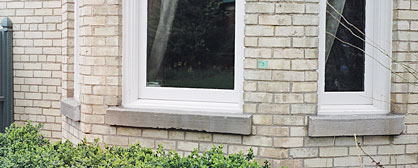
Given this information, we have an approximate guide for when Portland cement was first used in the construction of U.S. buildings. There are always exceptions to the rules, but based on my work and observations, if a structure was built between the mid 1880s and sometime in the 1930s, it most likely needs to be repaired with a mortar that consists of lime putty, some Portland cement, sand and color pigment - considered a traditional lime-based mortar.
However, if the building was constructed prior to 1872 - or, depending on the region, even up to 1890 - it should be repaired with a lime-based mortar consisting only of lime putty, sand and color pigment.
Chemistry 101
It is important that masons and mason contractors involved in restoration work understand the properties of lime.
 |
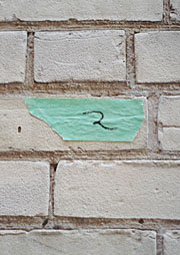 |
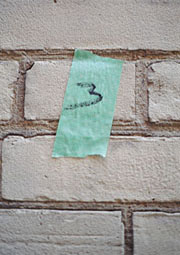 |
The mortar joint to the right of the green tape represents a sample produced using a straight lime and sand mix on this 19th century gothic revival house. The third one was adequate for use. |
||
Portland cement, the chief ingredient in today's masonry mortars, sets by adding water, which is called a hydraulic action. Using a quite different process, lime sets over time through a reaction with air, called a carbonation process.
Limestone, chalk and seashells are essentially calcium - calcium carbonate to be precise. Lime is derived from heating limestone (or chalk or sea shells) at high temperatures, which drives off the carbon dioxide that is part of its chemical composition and turns the limestone into quicklime, or calcium oxide.
When water is added to the quicklime, it generates heat, called an exothermic reaction. In the trade, we call this process "slaking" the lime. If the lime is made into a powder at this stage, it will become the lime you may have seen sold at masonry supply stores, called hydrated lime. However, if you add excess water during the slaking process, the lime will turn into putty. (To some confusion, hydrated lime and lime putty are chemically almost the same, and both are referred to as "calcium hydroxide.")
The longer lime is left as putty, the more workable it will be in the end. Over time, the lime putty undergoes a process whereby the lime crystals reduce in size upon aging and transform into small plates that slide when rubbing against each other. This action allows more water to be absorbed, giving lime the property of being highly workable, or having "plasticity."
While Portland cement hardens due to the chemical reaction with the water, if stored in a sealed container, lime putty will remain workable and soft indefinitely. Lime will harden over time only when it comes in contact with carbon dioxide and moisture.
Once a lime-sand mortar is mixed and placed in the wall, the water will begin to absorb or evaporate and the mortar will appear to set after several hours. However, the lime then begins to react with the carbon dioxide present in the air and harden, a process that actually will take years to complete. A simplified explanation is that, chemically, the lime is returning to its former state of being a stone.
A more complex explanation is that the carbon dioxide and moisture convert the lime on the surface of the joint back to calcium carbonate. The open pore structure of the lime-based mortar allows the carbonation process to take place deeper in the joint over time.
Why Lime Mortars are Used
Any renovations to structures built with a lime-sand mortar should be completed with a similar lime-sand mix. Unlike today's cement-based mortars, lime mortars are flexible and will take slight movement and settlement in the brick wall.
Also, unlike the modern-day cavity wall, moisture movement in and out of the wall is very much part of the system. Modern brick is harder, more vitreous and impervious to water penetration, while old brick is soft and porous. While brick walls of today are made to shed water like a raincoat, old brick walls are much like wearing an overcoat - they get wet, but then dry out by evaporation. Older brick benefits from the use of permeable lime mortar because it allows the moisture that has penetrated the brickwork to escape through the joint and not through the brick unit. Although older brick is quite weatherproof, this sacrificial type of mortar allows the brick to suffer the abuse caused by the elements and stand a better chance of being preserved.
Finally, lime mortars are cleaner to work with, as a result of being plastic and more workable, and their appearance and color blend harmoniously with a mortar of the same composition. In contrast, common cement-based mortars produce a grisly result on older structures.
Certainly, the work could be made easier, and consequently cheaper, by using a Type K mortar comprised of sand, lime and white Portland cement; however, the better option is to use only a lime and sand mortar on buildings that have been constructed using such materials.
Tips and Tricks
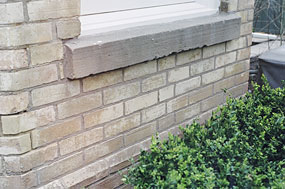 The area below the windowsill was entirely repointed using the mix chosen from the sample. |
First, the wall must be kept damp for several days after the lime-sand mortar is applied so that the carbonation process has the necessary time to start before the wall is allowed to dry out. As mentioned earlier, lime mortars can appear to have set. If you are tricked by this and allow the mortar to dry too quickly, it will not have fully started its reaction with carbon dioxide present in the air. With a lack of moisture causing an abbreviated carbonation process, the lime mortar will be so weak that harsh winter conditions could be sufficient enough to make it fall out as early as within the first year.
As I've suggested throughout this article, a straight lime and sand mixture takes a much longer time to set. To accelerate the set and increase its durability in exposed locations, you can add pozzolanic additives to lime mortar.
The most commonly used pozzolans are: brick dust made by crushing and sieving soft, under-burnt bricks; volcanic ash, called trass; or calcined china clay, sold under the name of Polestar or Metastar. These are specialized restoration products that rarely get used on modern projects. (The name 'pozzolan' came from the Romans' use of volcanic dust from the region of Pozzuoli in Southern Italy for the purpose of introducing hydraulic qualities to an otherwise non-hydraulic lime-sand mortar mix.)
Another option for a faster setting mortar is to use hydraulic lime, which is made by burning limestone and the impurities found within it, such as clay. Hydraulic lime undergoes partial hardening by reaction with water - much like a "gauged" mortar, which is a lime-based mortar that contains Portland cement to make it artificially hydraulic. This setting property of hydraulic lime derives from the presence of the impurities that, upon slaking, react with the lime in the presence of water, forming solid crystals. Proportions of these impurities occurring in the limestone and combined during the burning affect the strength of the lime and the speed with which it will harden. A low proportion of impurities will produce a feebly hydraulic lime, while a higher proportion will yield a moderately or eminently hydraulic lime.
When using a straight lime and sand mix that contains pozzolans, or when using a hydraulic lime mix, the carbonation process can still take place. However, when working with gauged mortars, the lime provides plasticity, but the Portland cement reportedly prevents the carbonation from occurring. The Portland cement provides the strength, basically at that point.
It is also important not to apply a lime-sand mix, without the addition of any Portland cement, within a month of freezing point temperatures.
Finally, abundantly spray the joint prior to applying the mortar. It is also very important to cover the wall with a tarp or wet burlap for several days, and to keep the wall wet. I usually keep the tarp on the wall for five days and try to spray the wall three to seven times a day during this period.
The caution with using a pure lime and sand mix is that one must really follow set, known guidelines. Time will do the rest.
About the Author
Mario Cantin, president of Invisible Tuckpointing Ltd., located in Ontario, Canada and Lewiston, N.Y., offers brick mortar replacement with a perfect color match and teaches others how to earn a six-figure income doing the same.
All photos courtesy of Mario Cantin/Invisible Tuckpointing Ltd.


















